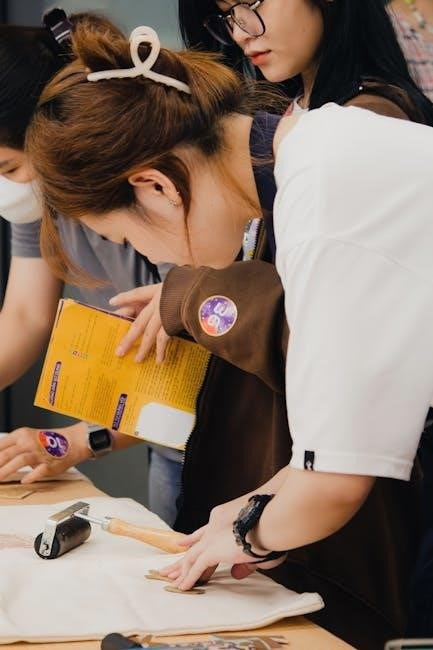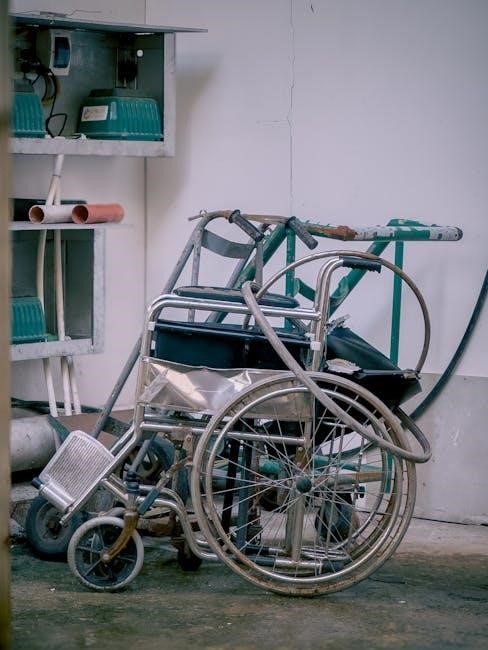Welcome to the First Aid/CPR/AED Participants Manual, a comprehensive guide for emergency response training. This manual serves as an essential resource for individuals seeking to learn life-saving skills.
It covers critical techniques for first aid, CPR, and AED use, ensuring preparedness in medical emergencies. The manual is part of the American Red Cross program, designed to empower participants with practical knowledge and confidence.
Overview of the Manual
The First Aid/CPR/AED Participants Manual is a detailed guide designed to equip individuals with essential skills for emergency response. It covers first aid, CPR, and AED techniques, providing clear instructions for various scenarios. The manual is part of the American Red Cross program, ensuring evidence-based and updated practices. Key sections include assessment of the scene, universal precautions, and step-by-step procedures for CPR and AED use. It is intended for diverse audiences, from workplace employees to community members, aiming to foster confidence and competence in saving lives during critical situations. The manual is available in PDF format for easy access and reference.
Purpose and Scope
The purpose of the First Aid/CPR/AED Participants Manual is to provide individuals with the essential knowledge and skills to respond effectively in emergency situations. Its scope includes training for adults, children, and infants, covering first aid, CPR, and AED use. The manual prepares participants to assess scenes, call for help, and perform life-saving interventions. It emphasizes practical application, ensuring readiness in real-world emergencies. Designed for diverse audiences, the manual serves as a critical resource for workplace, community, and individual use, aligning with the latest guidelines to promote confidence and competence in emergency response.
Target Audience
The First Aid/CPR/AED Participants Manual is designed for individuals seeking to gain or renew certification in emergency response. It is ideal for workplace employees, healthcare professionals, educators, coaches, and community members. The manual caters to both novice learners and those refreshing their skills, providing clear, concise instruction. Its practical approach ensures that participants from diverse backgrounds can effectively apply the techniques learned. Whether for professional requirements or personal preparedness, this manual equips individuals with the confidence and knowledge to act decisively in critical situations, making it a valuable resource for anyone committed to saving lives.

Importance of First Aid and CPR/AED Training
First aid and CPR/AED training empowers individuals to respond confidently in emergencies, potentially saving lives and reducing injury severity until professional help arrives.
Why First Aid Training is Essential
First aid training is crucial for empowering individuals to provide immediate care during medical emergencies, often saving lives and reducing the severity of injuries. It equips participants with the skills to assess situations, control bleeding, and stabilize conditions until professional help arrives. Proper first aid techniques can prevent minor injuries from becoming serious and reduce recovery time. Additionally, it promotes a sense of responsibility and confidence, enabling individuals to act decisively in critical moments. The American Red Cross manual emphasizes these principles, ensuring participants are well-prepared to handle emergencies effectively and responsibly.
The Role of CPR in Saving Lives
CPR (Cardiopulmonary Resuscitation) plays a vital role in saving lives during cardiac emergencies. By manually compressing the chest, CPR restores blood circulation and oxygen supply to the brain and other organs. This intervention is critical when a person’s heart stops beating, as it buys time until professional medical help arrives. Immediate CPR can double or even triple the chances of survival for someone in cardiac arrest. The American Red Cross manual emphasizes proper CPR techniques, ensuring participants can act confidently and effectively in life-threatening situations. Timely CPR is often the difference between life and death.
How AEDs Revolutionize Emergency Response
Automated External Defibrillators (AEDs) have revolutionized emergency response by providing immediate intervention for cardiac arrest. These devices analyze heart rhythms and deliver life-saving shocks when necessary. AEDs are designed for ease of use, guiding users through audio and visual prompts, making them accessible even to those without medical training. Their portability enables rapid response in various settings, from workplaces to public spaces. Real-time feedback, as seen in models like the ZOLL AED PRO, ensures proper chest compressions, enhancing effectiveness. AEDs significantly improve survival rates when used alongside CPR, empowering individuals to act decisively in critical moments and bridging the gap until professional help arrives.

Structure of the Participants Manual
The manual is organized into key sections, including introduction, basic first aid, CPR techniques, AED usage, and special considerations, providing a clear, logical flow for learners.
Key Sections of the Manual
The manual is divided into clear, logical sections to ensure comprehensive learning. It begins with an introduction, followed by basic first aid concepts, CPR techniques, and AED usage. Additional sections cover first aid for specific emergencies, such as wounds, burns, and fractures, as well as special considerations like care for infants and remote settings. Legal and ethical considerations are also addressed, providing a well-rounded understanding of emergency response. Each section builds on the previous one, ensuring participants gain practical skills and confidence to act effectively in critical situations. This structured approach makes the manual an essential resource for training.
Navigating the PDF Format
The First Aid/CPR/AED Participants Manual is available in a convenient PDF format, designed for easy access and navigation. The document is structured with clear bookmarks and hyperlinks, allowing users to quickly locate specific sections. Key sections include emergency care procedures, CPR techniques, and AED usage, all organized for seamless navigation. The PDF format ensures portability, enabling participants to review the manual on various devices. Interactive features, such as clickable tables of contents, enhance the learning experience. This format is ideal for both self-study and instructor-led training, making it a practical tool for mastering life-saving skills. The PDF is widely compatible and user-friendly, ensuring accessibility for all learners.

Basic First Aid Concepts
Mastering basic first aid concepts is crucial for providing immediate care in emergencies. Key principles include ensuring safety, assessing the situation, and preventing further harm or injury.
Assessment of the Scene and Victim
Assessing the scene and victim is the first step in providing effective first aid. Ensure personal safety and the victim’s safety before intervening. Check for responsiveness by asking questions or tapping gently. Look for signs of injury, illness, or bleeding. Note the victim’s position and condition. If the victim is unresponsive, call for emergency help immediately. Universal precautions should be applied to prevent infection. Assess breathing and circulation, and prepare for CPR if necessary. A thorough assessment helps prioritize care and ensures timely interventions. Always follow the Check, Call, Care approach for optimal emergency response.
The manual emphasizes these critical steps to save lives effectively.
Calling for Emergency Help
Calling for emergency help is a critical step in any first aid situation. Dial the local emergency number immediately if the situation is life-threatening. Provide clear, concise information about the location and nature of the emergency. Stay on the line until help arrives. If alone, call for help first before assisting the victim. In workplaces, activate the emergency alarm system if available. Remember the Check, Call, Care sequence to ensure timely medical response. Prompt action can significantly improve outcomes in critical situations. Always prioritize calling for professional help before administering care.
This step is vital for ensuring expert assistance arrives quickly.
Universal Precautions for Infection Control
Universal precautions are essential to prevent the transmission of infectious diseases during first aid. Always wear personal protective equipment (PPE), such as gloves and masks, when in contact with bodily fluids. Wash hands thoroughly with soap and water after providing care. Use disposable supplies and avoid direct contact with blood, vomit, or other fluids. Properly dispose of soiled materials and disinfect surfaces. These measures protect both the rescuer and the victim. Familiarize yourself with exposure control protocols to ensure safety in emergency situations. Adhering to these guidelines minimizes infection risks and maintains a safe environment for care.
Always prioritize hygiene and safety.

CPR Techniques
CPR techniques involve assessing the victim, starting chest compressions, and providing rescue breaths. Maintain a rate of 100-120 compressions per minute. Use an AED if available. Follow proper hand placement and depth guidelines for effective compressions. Ensure the victim’s airway is open and provide breaths after every 30 compressions. Continuous, high-quality CPR maximizes chances of survival until advanced care arrives. Proper technique is critical for maintaining blood circulation and oxygen supply to vital organs during cardiac arrest. Training and practice are essential to master these life-saving skills effectively and confidently in emergency situations. Always follow updated guidelines for best practices.
Adult CPR Procedures
Adult CPR procedures begin with assessing the scene and the victim’s responsiveness. Call for emergency help if unconscious. Place the person on their back on a firm surface. Position hands one on top of the other, center of the chest, and perform compressions at 100-120 per minute. Allow chest recoil fully between compressions. If trained, provide rescue breaths after every 30 compressions. Use an AED if available. Attach pads, analyze, and deliver a shock if advised. Continue compressions until emergency services arrive. Proper technique ensures blood circulation and oxygen supply to vital organs during cardiac arrest. Training is crucial for effective execution. Follow updated guidelines for best practices and maximize survival chances.
Child and Infant CPR
Child and infant CPR differs from adult CPR due to anatomical and physiological differences. For children (1-12 years), compressions are performed with one hand or both hands if the rescuer is small. Use the heel of one hand for infants (0-12 months), placing thumbs center of the chest. Compression depth for children is 2-3 inches, and for infants, about 1/4 inch. Rescue breaths are included in both cases. Use an AED with pediatric pads for children and infants if available. Training emphasizes proper technique to ensure effective circulation and oxygenation. Immediate action can significantly improve survival rates in young victims of cardiac arrest.
Hands-Only CPR
Hands-Only CPR is a simplified technique for untrained bystanders to help save lives. It involves chest compressions without rescue breaths, making it easier to perform. Call 911, place hands one over the other, and push to the beat of “Stayin’ Alive” (100-120 BPM). This method is effective for adults and teens in cardiac arrest. It maintains blood circulation and increases survival chances until professional help arrives. Hands-Only CPR is promoted to reduce hesitation and empower individuals to act in emergencies. Training emphasizes proper technique to ensure maximum effectiveness. Early intervention is critical for improving outcomes in cardiac arrest scenarios.

Using an Automated External Defibrillator (AED)
An Automated External Defibrillator (AED) is a portable device that analyzes heart rhythms and delivers life-saving shocks. It improves survival chances in cardiac arrest when used promptly.
How an AED Works
An Automated External Defibrillator (AED) is a portable medical device designed to analyze heart rhythms and deliver electrical shocks to restore normal heart function during cardiac arrest.
It operates by attaching electrode pads to the victim’s chest, which monitor the heart’s electrical activity. The AED then interprets the rhythm to determine if a shock is needed. If necessary, it charges and delivers a controlled shock to interrupt abnormal heart activity, allowing the heart to re-establish a normal rhythm. Modern AEDs provide voice prompts and visual instructions, guiding users through the process. This lifesaving technology is crucial for increasing survival rates when used promptly and correctly in emergency situations.
Step-by-Step AED Usage
Using an AED involves a straightforward process to ensure effective emergency response. First, turn on the device by opening the lid or pressing the power button. Attach the electrode pads to the victim’s bare chest as indicated by the diagrams or voice prompts. Ensure no one touches the victim while the AED analyzes the heart rhythm. If a shock is advised, deliver it by pressing the shock button. After each shock, resume CPR, starting with 30 chest compressions, until emergency medical personnel arrive. Always follow the AED’s voice instructions and avoid delaying CPR after a shock is administered. Proper use can significantly improve survival chances.
Common Mistakes to Avoid
When using an AED, it’s crucial to avoid common errors that can delay effective treatment. One major mistake is not turning on the device promptly or failing to follow voice prompts. Another error is improper placement of electrode pads, which can reduce the AED’s effectiveness. Avoid delivering shocks unnecessarily or interrupting CPR after a shock. Ensure no one touches the victim during analysis or shock delivery. Additionally, not resuming CPR after a shock is a critical oversight. Always adhere to the AED’s instructions and avoid delaying compressions. Proper training and practice can help minimize these errors, ensuring better outcomes in emergencies.

First Aid for Specific Emergencies
Recognizing and responding to specific emergencies like wounds, burns, and fractures requires tailored techniques. This section covers immediate care for common incidents, empowering individuals to act confidently and effectively.
Wounds and Bleeding
Proper management of wounds and bleeding is critical to prevent infection and promote healing. Assess the wound for depth and debris, then clean it with cool or lukewarm water. Apply gentle pressure to control bleeding and use a sterile dressing or bandage. For severe bleeding, elevate the injured limb above heart level and consider using a tourniquet if trained. Monitor for signs of shock, such as pale skin or rapid breathing, and seek immediate medical attention if the wound is deep or won’t stop bleeding. Always prioritize infection control and use protective gear when handling blood.
Burns and Scalds
For burns and scalds, immediately cool the affected area with cool tap water for 10–15 minutes. Remove clothing or jewelry near the burn, as these can stick to the skin. Apply a sterile, non-stick dressing to protect the wound. Do not use ice or apply butter, as these can worsen the injury. For minor burns, cooling and covering are sufficient. However, seek immediate medical attention for severe burns, electrical burns, or burns covering large areas. Signs of severe burns include charred skin, difficulty breathing, or loss of consciousness. Prompt treatment is essential to prevent infection and promote healing.
Fractures and Sprains
For fractures, immobilize the affected limb using a splint or sling to prevent further injury. Do not attempt to straighten or move the bone. Apply ice to reduce swelling. For sprains, follow the RICE method: Rest, Ice, Compression, and Elevation. Avoid putting weight on the injured area. Seek medical attention if there is severe pain, deformity, or inability to move the limb. Proper first aid for fractures and sprains helps prevent complications and promotes healing. Always consult a healthcare professional for further treatment and rehabilitation.

Special Considerations
- Provide tailored first aid for infants, children, and adults in unique situations.
- Follow infection control measures to ensure safety for both the responder and victim.
- Be aware of legal and ethical responsibilities when providing care in emergencies;
First Aid for Infants and Children
First aid for infants and children requires specialized techniques due to their smaller size and developing bodies; The manual emphasizes age-specific methods for addressing choking, burns, and fractures. It also covers how to handle airway obstruction and cardiac emergencies in pediatric cases. Proper techniques for CPR and AED use on children are detailed, ensuring responders can act confidently. Additionally, the guide highlights prevention strategies and the importance of quick action in critical situations involving young victims. Understanding these differences is crucial for effective care and improving outcomes in emergencies.
First Aid in Remote or Wilderness Settings
First aid in remote or wilderness settings requires unique skills due to the lack of immediate medical assistance. The manual addresses situations where help may be delayed, emphasizing self-reliance and resourcefulness. It covers techniques for managing wounds, fractures, and exposure in isolated environments. Special attention is given to improvising with available resources and stabilizing injuries until professional help arrives. The guide also discusses prevention strategies, such as recognizing hazards and preparing appropriately. These skills are vital for ensuring survival and minimizing harm in remote areas, where access to advanced care is limited. Proper training is essential for effective response in these challenging conditions.

Legal and Ethical Considerations
Understanding legal and ethical responsibilities is crucial in first aid/CPR/AED training. Good Samaritan laws protect responders, while certification ensures compliance with standards, minimizing liability risks during emergencies.
Good Samaritan Laws
Good Samaritan laws protect individuals who provide first aid, CPR, or AED assistance in emergencies. These laws vary by location but generally shield responders from liability if they act in good faith. They encourage bystanders to assist without fear of legal consequences, provided the care is reasonable and within their training. Understanding these laws is crucial for responders, as they clarify the legal protections available when helping others in critical situations. Always ensure actions align with training and guidelines to remain protected under such laws.
Liability and Certification
Liability concerns are addressed through proper training and certification in first aid, CPR, and AED use. Certification ensures responders have the necessary skills to act competently in emergencies. Most programs require completion of a recognized course and passing both practical and written exams. Certification typically remains valid for two years, after which renewal is needed. Proper training minimizes liability risks, as it ensures actions align with accepted standards. Certification also demonstrates a commitment to providing care responsibly, which is essential for legal and ethical emergency response. Always verify certification requirements with the issuing organization to maintain compliance and confidence in your abilities.

Maintaining Your Certification
To maintain certification, complete renewal courses and continuing education as required. Stay updated on the latest techniques and guidelines to ensure proficiency in first aid, CPR, and AED use.
Renewal Process
The renewal process for First Aid/CPR/AED certification typically occurs every two years. Participants must complete an abbreviated training course, which includes both theoretical and practical components. The renewal course reviews key skills, such as CPR techniques, AED usage, and first aid procedures, ensuring participants remain proficient. Many organizations, like the American Red Cross, offer renewal courses in various formats, including in-person and online options. Upon successful completion, participants receive updated certification. Regular renewal is essential to maintain competency and stay informed about the latest emergency response guidelines and techniques.
Continuing Education Requirements
Continuing education is crucial for maintaining First Aid/CPR/AED certification. Most programs require participants to complete refresher courses every two years. These courses ensure skills remain current and align with updated guidelines. The American Red Cross and other organizations offer in-person and online options for continuing education. Participants must demonstrate proficiency in both theoretical knowledge and practical skills, such as CPR techniques and AED usage. Staying informed about the latest emergency response practices is essential for providing effective care. Regular training reinforces confidence and readiness in real-world scenarios, ensuring individuals can act decisively during medical emergencies.
Mastering first aid, CPR, and AED skills is vital for saving lives. Regular practice and staying updated ensure confidence and effectiveness in emergencies.
Final Tips for Effective Emergency Response
Stay calm and assess the situation quickly. Always follow the ABCs of first aid: Airway, Breathing, and Circulation. Use an AED if available and trained. Remember, immediate action can significantly improve outcomes. Regularly review and practice skills to maintain proficiency. Keep first aid kits and AEDs accessible and inspected. Stay updated on the latest guidelines and techniques. Encourage others to learn these life-saving skills. Confidence and preparedness are key to effective emergency response. Always prioritize safety for both the victim and responder.
The Importance of Practicing Skills
Regular practice of first aid, CPR, and AED skills is crucial for effective emergency response. Muscle memory developed through practice ensures confident and accurate actions during high-stress situations. Reviewing techniques helps maintain proficiency and adapts to updated guidelines. Hands-on training reinforces learning, making it easier to apply skills in real emergencies. Consistent practice also reduces hesitation, allowing responders to act swiftly and correctly. Stay proficient by engaging in regular drills and refreshers to enhance your ability to save lives effectively.
